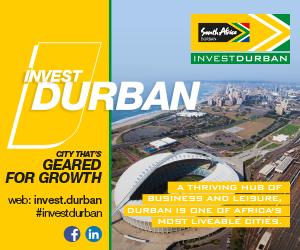With several coal mines reaching the end of their lives, steps are being taken to convert the land to useful agricultural land. Safety and health concerns will have to be addressed, but there is potential to improve food security for poorer families in the province.
A number of off-take agreements have been signed between commercial and emerging farmers and wholesalers and distributers in Oman.
A provincial programme called Phezukomkhono Mlimi is providing mechanisation and input support to subsistence and emerging farmers and households which are engaged in agriculture. Farmers receiving support from government are expected to enroll in courses offered by the AgriSETA. The Fortune 40 programme has a specific focus on developing young entrepreneurs in farming. Twelve of the Fortune 40 farms have been linked to retailers such as Spar, Shoprite and Boxer and with wholesalers and agri-hubs.
The goal is to have an agri-hub in each of the province’s three districts. Small-scale farmers and co-operatives are being given a chance to connect to the formal economy via the hubs which will also provide advice and equipment.
The Mkhuhlu agri-hub in Bushbuckridge, which forms part of the Provincial Government Nutrition Programme, is operational.
The Mkhondo agri-hub in Gert Sibande District is completed and partially operational. The plan is for it become fully operational in the next financial year. A feasibility study is underway relating to the establishment of a hub in the Nkomazi Municipality. A budget of R15-million has been agreed for the first phase and the creation of a pack-house. An International Fresh Produce Market is planned as a means of stimulating agricultural production, but the project has stalled.
Other interventions include the re-commissioning of the Bushbuckridge poultry abattoir and support for soya and maize farmers to supply the Lekwa Oilseed Crushing Plant in Standerton.
Agriculture is responsible for about 3.4% of Mpumalanga’s Gross Domestic Product (GDP).
Crops
Mpumalanga accounts for about 21% of South Africa’s citrus production and a third of its export volumes, with Valencias being the province’s most popular varietal and Nelspruit being the centre of the sector.
Avocados, litchis, mangoes and bananas thrive in the province. Hazyview is an important source of bananas, with 20% of South Africa’s production originating there. Deciduous fruits are cultivated in smaller quantities. About 15 000 tons of table grapes are produced in the province annually and Mpumalanga produces its own wine.
A specialist fruit that does well in the province is the marula. The marula fruit makes a popular beer and is used in the production of a liqueur that has done well on the international market.
See also: Marula Industrial Hub to boost the use of this super fruit
Macadamia nuts have grown in popularity exponentially. About 4 000 hectares of new trees is added each year across South Africa, with most of that in Mpumalanga and neighbouring Limpopo. The vast majority of the nuts are exported, with about 40% going to China.

There are about 450 farmers growing the nuts and there are 14 cracking factories in South Africa. The sector employs about 4 500 people, of which 1500 are permanent employees. Barberton and Hazyview are two prime areas for the nut.
Mpumalanga produces one-million tons of maize from 291 788 ha. About 53 000 tons of wheat and 33 000 tons of sorghum are produced annually. Soya bean is another major crop: more than half of South Africa’s soya bean crop is produced in Mpumalanga’s Highveld areas.
Cotton is grown mostly under dryland conditions in Marble Hall. The province has 1500 ha of dryland under cotton. Much of South Africa’s total annual production of about 34-million kilograms of tobacco, especially Virginia tobacco, takes place in the north-western parts of Mpumalanga, and in neighbouring Limpopo. Other crops produced for export in Mpumalanga include cut flowers, pot plants and nursery plants.
 Mpumalanga has the second-biggest sugar industry in South Africa, after KwaZulu-Natal.
Mpumalanga has the second-biggest sugar industry in South Africa, after KwaZulu-Natal.
TSB Sugar runs three mills in the Lowveld region, two of which have refining capacity, and employs about 4 700 people. More than 1 400 farmers (commercial and small-scale) deliver sugar cane to the company. TSB brands are Selati (sugar) and Molatek (animal feed).
Companies
Astral Foods runs a poultry processing plant in Standerton which has 2 425 employees. Fresh fruit and nut supplier Halls cultivates 375 ha of its own land and has another 1 400 ha under management. Its crops include avocados and litchis.
Westfalia is a diversified agricultural group which runs extensive operations in the province. Umbhaba Estates is one of the biggest banana growers in the province. The drier Highveld region with its cold winters supports crops such as cereals, legumes and nuts. There is extensive irrigation in the Loskop Dam area. Ermelo is one of South Africa’s main centres of sheep farming and wool production.
Subtropical fruit flourishes in the Lowveld with the town of Nelspruit being a major citrus producer. Mixed farming and potatoes, sweet potatoes and beans are mostly found in the southern and western parts of the province.
More sector resources:
Fresh Produce Exporters’ Forum: www.fpef.co.za
Macadamias South Africa: www.samac.org.za
South African Cane Growers’ Association: www.sacanegrowers.co.za
South African Subtropical Growers’ Association: www.subtrop.co.za
Citrus Growers Association: www.cga.co.za






